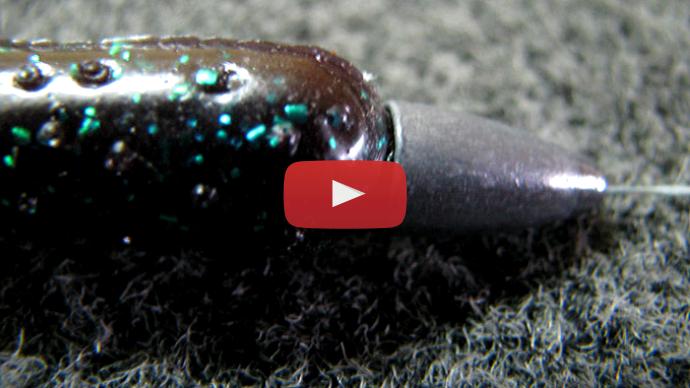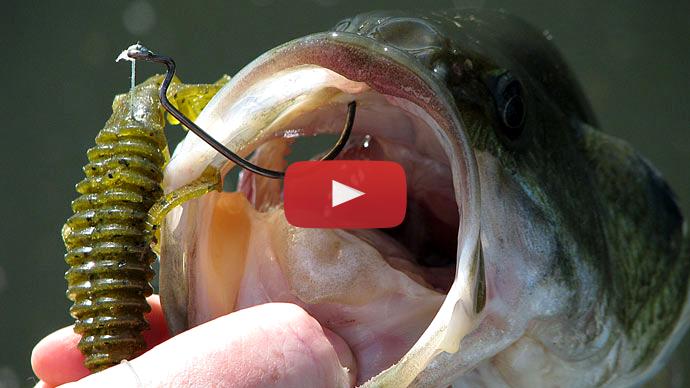Aaron: Yes, Tungsten on the drop shot. And I insert my weights, there's a video on YouTube about that, you have to insert your Tungsten weights, if they don't have them. But you have to watch that video. Only 5,000 people watched that video. I think it's the most important one out there for Tungsten users. And what all the pros are doing now, I take my shrink tubing, and stretch it, and put it in the weight, then before you pull it through you cut the back end of it off, and it makes a perfect insert, and it lasts longer than any insert anybody else uses, shrink tubing. With most of the weights, I can do two or three weights a minute, if you get on a roll, but it lasts, I can catch 100 fish sometimes... shrink tube is really good stuff. But it's tricky, I did a video on it, and I did it real slow, and I showed people, because it's tricky.
Interviewer: So what do you do with the shrink tubing?
Aaron: Like if you get somebody that's never done it, and a weight, it'd take 'em forever to figure it out.
Interviewer: Okay, so let's draw it. We'll draw it out here.
Aaron: There's a video on it, YouTube.
Interviewer: We'll be the artist this time, so what do you do?
Aaron: You stretch it...
Interviewer: So, the drop shot, okay, don't laugh, I'm not an artist here.
Aaron: You're going to draw it? Are you good?
Interviewer: All right.
Aaron: Well, the drop shot, you don't need an insert.
Interviewer: Oh, you don't?
Aaron: No, a bullet weight. Here, I'll show you, I can probably draw a bullet weight. Here's a bullet weight. So you have a bullet weight, and say the hole up here, and you've got shrink tubing, which is like, which is about the size you use for that, which is a smaller size. You take a lighter and heat it up about, you know, you take a piece of shrink tubing, heat up the end of it, I'll just use my bare fingers, my fingers are tough, you'll burn your fingers pretty good, but it doesn't burn your fingers bad. I've had black stuff stuck to my thumb everywhere, it doesn't burn bad, but it blisters.
I heat it up just right, and you kind of turn it a little bit, so you heat both sides of the shrink tubing, so it melts, and you pull it, so it elongates this piece, so it's skinny. So now you've made it this long, and this part's still fat. So you take your skinny end, and you take a pair of scissors and cut the end of the shrink tubing off at an angle, where it's flattened from your finger. Then that part you slide into the weight, I mean I don't have to draw it, you slide the skinny part into the weight now, you had to cut that flat part or you can't get in the hole of the weight, but the part you stretch is skinny, and goes through there pretty easy.
And you get hold of it on the other end, with usually your finger or sometimes you can use pliers, and don't turn it or it'll break, keep the pliers real straight and pull it. And you can pull the shrink tubing into the weight. And some weights are different, where you have to heat up maybe a tiny bit of it, to get it through, but most of the time, if you get the right shrink tubing, you can slide it all the way through, the new stuff, the stuff that hasn't been shrunk yet, you can slide it into the weight. And before you pull it all the way through, you cut the back end off, part will be sticking out the back of the weight.
The weights here, I'll cut it off like, it's hard to show. To pull it through, the new part's going to be right there, you go back here and cut the shrink tubing off the back, and then you pull it the rest of the way through to the bottom. Actually when it goes to the bottom of the weight, where the hole is, it actually flares out, mushrooms out, and it makes a perfect spot for the knot to hit, and there's no impact. And that part's done.
You take the top part, usually it's sticking out and it's skinny because you stretched it, and I cut it off right there. And then you heat that up, and it'll bring it down, and make it fatter again, it'll press into the weight, and it never slips out. It's the best insert there is, but it's hard to do, so that's why you don't see them in weights, because it's too hard to do. I showed it to a lot of companies, it's just too much for them. They use just, like a straight piece of plastic, I pull those out, because I don't like those. Mine's so much better.
Interviewer: So you just build a new liner for all of them?
Aaron: Yeah, I mean, lead weights you don't need to do it, it's Tungsten, you have to do it. Like I had arguments with True Tungsten while I was with them, they were giving me weights, but they had to insert them because...I always get a glass or a tile table, you know, you drop a glass, it's going to shatter, and that's kind of how fluorocarbon is, you know you've got glass and you've got Tungsten, the hardest material in the world, one of them, one of the top three or so, hitting each other, it's going to shatter the line, because fluorocarbon's brittle.
Interviewer: So you're protecting your line?
Aaron: But mono will fray, and braid will break, and they all break. It all does the same thing on all lines. Especially fluorocarbon. So, there's been a lot of heartbreak out there because of that, tons. I mean, I know of a bunch of tournaments that have been cost because of that. Guys have lost tournaments, big tournaments, classics, because of that.
Interviewer: Is it just for the heavier weights?
Aaron: All of them. Because you see the hook on a little weight, the fish has it pinched in his mouth, you got to yank that weight out, who knows how fast it's going when you set the hook. So you're going to bring that little eighth ounce weight down on top of that knot real hard, with no insert, it'll cause break offs too. So it eliminates that completely, that little layer of shrink tube eliminates it 100 percent, no frays. Like, a braid will fray too, bad, and it eliminates the braid fray too. Shrink tube. I did a video on it, it's on YouTube.
Interviewer: It's only the Tungsten weights though, you said.
Aaron: Yeah, lead seems to be fine. I never had issues with lead. It's one of the softer materials.
Interviewer: Is it under Aaron Martens, or fishing...?
Aaron: Yeah, you can find it on my website, it's probably linked to my website still. I haven't looked at it in a while, but you'll probably find it under Aaron Martens, maybe, insert weight Aaron Martens, it'll probably come up. Or Tungsten weights inserted, it should have me on there, 'cuz I don't think there's another video on there. I checked it like a month ago, I was curious, and there only like 4,000 people have seen it, so there's a lot of people that still don't know about it.




